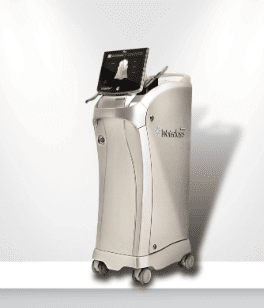Laser dentistry is one of the most advanced dental treatments today. A laser uses focused light energy with a stream of water for a highly precise, exceptionally gentle dental experience. As part of general dentistry, laser technology enhances treatments by reducing discomfort and speeding up healing.
The laser allows your dentist to perform a range of procedures. Some of the benefits include:
- Faster healing time and less trauma to teeth and gums
- Less pain in many instances, reducing the need for anesthetic for procedures
- Reduces anxiety in patients who are uncomfortable with the use of a needle or dental drill
- Making dental care a more relaxing experience for you
- Minimizes bleeding and swelling during soft tissue treatments
- Laser precision helps the dentist preserve healthy tooth structure during cavity removal

History of Dental Lasers
The first laser was developed in 1960 based on the theorized concept of stimulated emission by Albert Einstein in 1917. Medical and dental researchers have been developing practical applications ever since.
Dental researchers first reported in 1965 that a ruby laser could vaporize enamel. However, the thermal effects of continuous wave lasers at that time would damage the pulp. Other wavelengths were studied over the ensuing decades for both hard and soft tissue applications. In 1990, the first pulsed Nd: YAG laser designed specifically for the dental market was released. The year 1997 saw the FDA clearance of the first true dental hard tissue Er: YAG laser and the Er, Cr: YSGG a year later. Semiconductor-based diode lasers emerged in the late 1990s as well.

How Lasers Work
An Er, Cr: YSGG laser works by exciting water molecules and other molecules found in bone and teeth. A diode laser works by specific attraction to pigments in inflamed tissue. We use each of these in our office for many different procedures and applications.
The Er, Cr: YSGG has been found to cause far less discomfort for patients during cavity removal. There are several factors that contribute to this. Unlike with a dental drill, there is no heat or vibration. There is no contact with the tooth or pressure. From a biological perspective, it works by staying below the nerve threshold. Each pulse of the laser lasts just 50 millionths of a second where a nerve impulse takes one thousandth of a second.
Dental Laser Procedures at Mohr Smiles Dentistry
We use dental lasers for a variety of our treatments at Mohr Smiles in Tucson. We believe that lasers can improve the oral health and experience of many of our patients. Some procedures we offer include:
- Gingivectomy: A gingivectomy is contouring or shaping your gums using a laser to improve the look of your smile. We safely remove excess gum tissue that may give you a gummy smile, or make your front teeth look irregular in size or shape.
- Oral Growths Removal: Dr. Mohr can quickly and safely remove growths or excess tissue in your mouth. This includes gum tissue over an unerupted tooth, small tags called papilla, and growths called fibromas.
- Cold Sores and Canker Sores Treatment: We can treat cold sores and canker sores with only topical anesthetic. For canker sores, the laser forms a sort of natural bandage and immediately stop pain. Cold Sores usually disappear the following day, especially when treated early. The procedure takes only a few minutes and we are happy to fit you into our schedule at the first sign of a problem.
- Tongue Tie Treatment: Connections under the tongue that restrict its movement can cause speech and eating problems in children. When located on the outer part of your gums, it can cause gaps or early gum recession. Dr. Mohr can release this tissue more quickly and with less post-operative pain using a laser.
- Gum Disease Treatment: We use lasers to remove debris and bacteria between your teeth and gums that can cause frequent bleeding, gum recession and even tooth loss. We provide REPAIR minimally invasive periodontal treatment for moderate to severe gum disease and periimplantitis.
Patient Review
Dental Lasers in Pediatric Dentistry
A child’s early dental visits shape their attitude toward oral care. That’s why creating positive, stress-free experiences is at the heart of our approach. Whether your child needs a routine cleaning or more specialized care, we provide gentle treatment options with their comfort in mind.
We can address many common pediatric concerns, like tongue-ties, high frenums, and gum irregularities with little discomfort. Thanks to advanced techniques, procedures with lasers often don’t need anesthesia and allow for faster healing. Even restorative treatments have evolved. Where possible, Dr. Mohr uses drill-free and laser methods that help children feel more at ease.
By making each visit as comfortable as possible, our team helps young patients develop trust in dental care. This not only improves cooperation during treatment but fosters healthy habits that last well into adulthood. Our goal is to ensure your child’s smile stays bright and their dental experiences stay positive at every stage of growth.
Biostimulation Properties
Lasers have biostimulative properties that we can use to promote healing, bone and tissue regeneration, and promote post-operative comfort. For patients who have taken bisphosphonates and are at increased risk for osteonecrosis of the jaw (ONJ), bone surgery done with the laser has a reduced risk. ONJ occurs because the bisphosphonate drugs reduce osteoclastic activity in the bone. Since you need the activity to heal from surgical manipulation, ONJ can occur.
When manipulating bone with a laser, it minimally traumatized the bone. Therefore, you need less osteoclast activity in the bone for proper healing. Recent studies show that laser surgery of the bone results in better outcomes than traditional surgical approaches.
Lasers have so many applications in dentistry. These are just a few common ones. We welcome and appreciate your questions. If you have interest in learning more, please call Mohr Smiles Dentistry at 520-660-5666 or schedule an appointment online.
